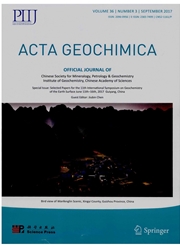

 中文摘要:
中文摘要:
吸附实验在在纳米大小的磅胶体和 PtCl4 2熊上在湖南和贵州省与更低的寒武纪的黑页岩系列 polymetallic 层联系的矿物质的不同类型上在房间温度和中立 pH 价值被做有一次尝试到的离子的答案在 polymetallic 抑制在矿物质的不同类型之间的关系层和铂组元素( PGE )的丰富。试验性的结果证明矿物质的不同类型显示出强壮的选择到纳米大小的磅胶体和 PtCl4 2 熊的吸附离子的答案。当石英,钠长石,白云母和另外的硅酸盐矿物质一个星期显示出 adsorbility 到他们俩时,金属性的硫化物,有机物和泥土矿物质是 PGE 的强壮的吸附物。这现象与在黑页岩系列的 polymetallic 层的金属性的硫化物,有机物和泥土矿物质是 PGE 的主要搬运人矿物质的地质的事实很好一致,把彻底的解释给以前的金属元素的丰富的机制。吸附可以是在更低的温度条件下面的宝贵金属元素的丰富的主要机制。上述的强壮的吸附物的存在是为 PGE 的丰富的好 geochemical 障碍。
 英文摘要:
英文摘要:
Adsorption experiments were made at room temperature and neutral pH value on different types of minerals associated with the Lower Cambrian black shale series polymetallic layers in Hunan and Guizhou provinces on nanometer-sized Pt colloids and PtC142--bearing ionic solutions with an attempt to constrain the relationship between the different types of minerals in the polymetallic layers and the enrichment of platinum group elements (PGEs). Experimental results showed that the different types of minerals show strong selectivity to the adsorption of nano- meter-sized Pt colloids and PtCla2--bearing ionic solutions. Metallic sulfides, organic matter and clay minerals are the strong adsorbents of PGEs, while quartz, albite, muscovite and other silicate minerals show a week adsorbility to both of them. This phenomenon is well consistent with the geological fact that metallic sulfides, organic matter and clay minerals in the polymetallic layers of the black shale series are the major carrier minerals of PGEs, giving a thorough explanation to the mechanism of enrichment of previous metal elements. Adsorption may be a principal mechanism of enrichment of precious metal elements under lower temperature conditions. The presence of the aforementioned strong adsorbents is the good geochemical barriers for the enrichment of PGEs.
 同期刊论文项目
同期刊论文项目
 同项目期刊论文
同项目期刊论文
 期刊信息
期刊信息
